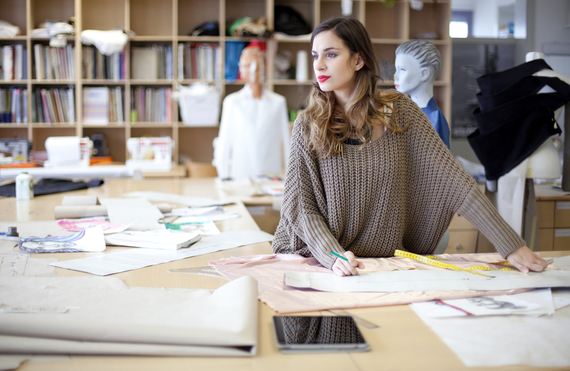Fashion is an ancient industry, and yet when it comes to ecommerce they're ahead of the game. The line between technology and fashion is starting to blur and we're beginning to see the rise of innovative, tech-focused fashion brands.
Brands like Burberry have showed us that the 'old guard' (Burberry was established in 1865) can easily keep up with newer, internet-founded companies with ease, and this makes for an exciting time as old and new test out what works and what doesn't in the Wild West of fashion ecommerce.
We've gone and identified some of these trends which may well come to define this world in the coming year.
Virtual-Reality Retail
In the race to improve customers' experience online, designers are working to reduce the number of clicks it takes for a visitor to become a customer. Web designers and user-experience experts are trying to bring the real-life experience of shopping to e-commerce: like recreating the texture, feel and fit of garments for an online shopper.
Body-scanning is a great example of these. The idea is it allows you to create a 3D image of yourself and dress it up and down, even see what you look after gaining or losing weight. It's not a new technology but has been held back in the past by demanding too much effort from the consumer (the expense of buying a body-scanner, uploading times etc.)
Now that the technology has matured, and we all have built-in laptop cameras to take high-res images - body-scanning could become a mainstream reality in just a few short years.
Lara Mazzoni is the co-founder of Bodi.me, a London-based startup that has worked to get this technology to digital retailers. Bodi.me works to change that making it possible to use the technology with a web-camera or their own full-body scanners. Which also has the advantage of saving retailers from setting up the logistics of body-scanning themselves.
A retailer that has tried something similar albeit on a smaller scale is eyewear retailer (and ecommerce site) Warby Parker. Each pair of lenses has a 'virtual try-on' option: you upload a picture of yourself and can see how the lens look on your face.
Bodi.me technology is starting to reaching the market and is being tested by some e-tailers in Europe. Why has it taken so long? Mazzoni says retailers know that body-scanning is a great technology, but aren't aware that's now usable as well.
Specifically, it now offers a "no-clicks solution," according to Vanessa Burrows, bodi.me's head of digital. They've designed the technology so it integrates with the website instead of being a feature for early-adopters or the tech-savvy. Once a body-scan has been created, there shouldn't be anything else a consumer need do.
Mazzoni is confident this technology will break into the big brand market in the next few years. "We have everything we need: the technology; the data, it's getting that to the brands." In other to do that, bodi.me needs to break down perceptions that body-scanning is a complex, unwieldy technology: "Their resistance is a cultural thing," she says.
Senseg's 'E-screen' technology, which uses electric fields to create sensations on monitors, is another nascent technology exploring its full UX potential: this mean a change in the way we manufacture the devices we use when shop for clothes online - the possibilities are inspiring for tech/fashion entrepreneurs.
Online Stylists
Sam Middleton co-founded The Chapar with his father to create a professional advice service for men. The website invites clients to suggest what kind of style they'd like to emulate and then a stylist sends them clothes to suit them. They can then send back any they don't want.
Middleton believes online stylists were a natural development: as it becomes clear that people want as organic an experience as possible, startups like Chapar are bringing very traditional occupations like a stylist to the web.
He calls this idea 'tech-enabled', rather than calling his a tech company. Middleton says "Especially in our case, an algorithm alone could not produce the service our customers deserve. [...] Our use of technology is centred on the idea of helping the human interaction, not replacing it."
MyStylit (beta, for women) and Thread (for both) also operate in this theatre - of offering fashion styling advice combined with an efficient retailing experience. It's a nascent idea, based off a very old concept.
Curation
Polyvore and Trendabl have arrived in the last 5 years to curate clothes across retailers and offer a more seamless shopping experience. There are also generalist curators with no particular focus like Pinterest and Fancy that have developed fashion/textile communities in recent years and Fancy often gives a direct purchase option for products.
There is an obvious demand for retail/curation hybrids: take Amazon as a key example: its actual Amazon-branded products make up a negligible percentage of total revenue (they actually lose money on each Kindle hardware sale, which they make up in ad revenue). Amazon carved their way as the Walmart of the internet - where the time saved by having so many products grouped together is a key selling point for the consumer.
That curator sites for fashion ecommerce websites were created isn't in itself surprising: but recent innovations like: 'search by image,' algorithms that 'learn' user preferences and larger, more dedicated online communities of fashion (the ones who populate Fancy and Pinterest) make these sites way more useful than they could have been even 5 years ago.
Social
Net-a-Porter, the luxury e-commerce site and trend-setter in their own right, has always tried to improve their digital experience -- and social has become a big part of their marketing efforts.
More recently they launched 'The Netbook,' which allows users to favorite, comment and share on a garment's page - and buy, of course. You can build profiles and pick 'style-icons' amongst the people you're following in hopes of imitating their style choices.
Sarah Watson, Porter's Group Mobile Manager, has been in charge of their mobile division and seen the release of a suite of apps (Net-A-Porter, Mr. Porter and The Outnet). She says on their decision to go social: "I think what's really key is you've got that constant feedback - we're able to listen to our customers, collect their feedback, and actually customize the experience. Which is really kind of powerful for us." As for developing revenue from this, she says their first priority is building a social network, and moving forward from there.
A social feature is also a powerful way to develop an intimate fan base, who use the platform to stop, chat and shop. Fancy and Pinterest, both mentioned earlier, also rely on 'Repins' and 'Fancys' to build a social following.
Data-driven innovation
Fashion is starting to take the market research potential in data very seriously. Specifically, data analysts can capture fashion trends in real-time: evaluating consumer responses through social media and online product reviews and, of course, make sense of data points like click-through, time spent on the website, etc.
Editd use data to identify fashion and retail trends, which it then delivers to clients as infographics. These clients include high-profile names like e-tail giant ASOS and Gap Inc. The startups business model is strictly upon the assumption that fashion retailers need and will pay for this information. Clearly, they do. And their not the only ones: WGSN is a fashion-trends forecaster which supplies similar data to fashion brands; and Olapic - who use consumer photos and videos from social media websites to improve their clients ecommerce experience.
A spokesperson for company says "In the past brands or retailers could only base decisions on their internal information. Now it's easier to measure the whole market's performance and identify opportunities to capitalize on. We package that data to help our clients."
Fashion trends are now being evaluated in terms of consumer behavior, garment colors and types and more - which are then packaged by data scientists and graphics teams to be delivered to clients - retail brands - which shapes branded e-commerce businesses today.
Perhaps we'd like to see fashion in a more colorful way: invisible boundaries of taste; fashion icons acting like the aristocratic nouveau. We're not moving away from this world as such: but combining it with increasingly sophisticated methods of sorting through large sets of data - the kind that get produced from when millions of people shop online.
As has been said so many times: the future is now. Fashion ecommerce is a melting pot of good ideas, amazing technology and inspiring entrepreneurs who don't want to necessarily disrupt the ecommerce space (though some do); but take what we have and improve it for the consumer. For everyone involved - leaders in retail, data scientists, designers and of course shoppers - this is a very exciting time for fashion retail.



